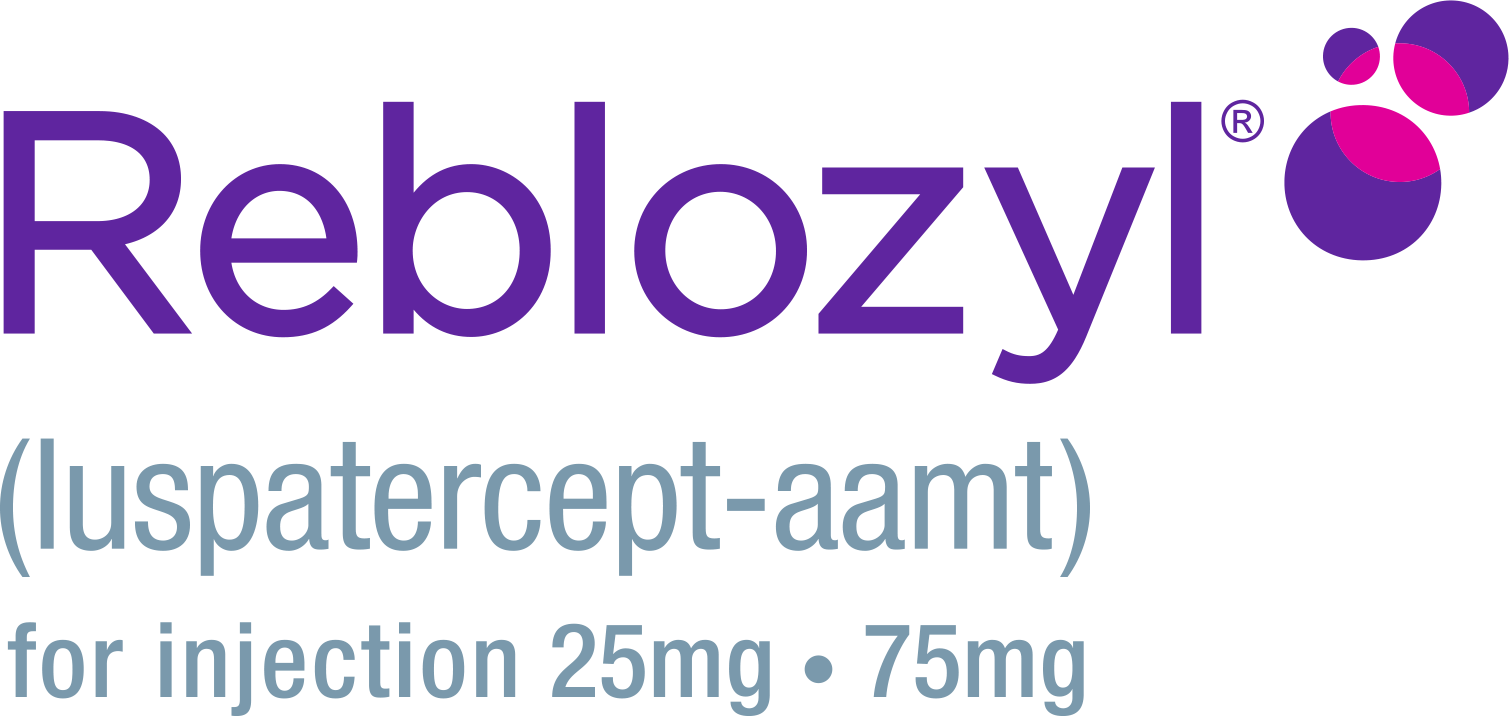| Body system/ adverse reaction |
REBLOZYL (n=182) | Epoetin Alfa (n=179) | ||
|---|---|---|---|---|
| All Grades n (%) |
Grade ≥3 n (%) |
All Grades n (%) |
Grade ≥3 n (%) |
|
| General disorders and administration-site conditions Fatiguea,b |
32 (17.6) | 1 (0.5) | 13 (7.3) | 1 (0.6) |
| Asthenia | 25 (13.7) | 0 (0) | 29 (16.2) | 1 (0.6) |
| Edema peripheral |
26 (14.3) | 0 (0) | 14 (7.8) | 0 (0) |
| Non-cardiac chest pain |
9 (4.9) | 1 (0.5) | 8 (4.5) | 0 (0) |
| Pyrexia | 11 (6.0) | 2 (1.1) | 13 (7.3) | 1 (0.6) |
| Gastrointestinal disorders Diarrhea |
32 (17.6) | 3 (1.6) | 25 (14.0) | 1 (0.6) |
| Nausea | 26 (14.3) | 0 (0) | 15 (8.4) | 0 (0) |
| Vascular disorders Hypertensiona |
27 (14.8) | 18 (9.9) | 16 (8.9) | 8 (4.5) |
| Respiratory, thoracic, and mediastinal disorders Dyspnea |
26 (14.3) | 8 (4.4) | 14 (7.8) | 2 (1.1) |
| Dyspnea exertional |
9 (4.9) | 1 (0.5) | 1 (0.6) | 0 (0) |
| Nervous system disorders Dizziness |
23 (12.6) | 1 (0.5) | 16 (8.9) | 0 (0) |
| Headache | 20 (11.0) | 1 (0.5) | 15 (8.4) | 1 (0.6) |
| Musculoskeletal and connective tissue disorders Back Pain |
22 (12.1) | 2 (1.1) | 16 (8.9) | 3 (1.7) |
| Arhralgia | 16 (8.8) | 1 (0.5) | 20 (11.2) | 0 (0) |
| Myalgia | 9 (4.9) | 0 (0) | 5 (2.8) | 0 (0) |
| Osteoarthritis | 9 (4.9) | 1 (0.5) | 7 (3.9) | 0 (0) |
| Infections and infestations COVID-19 |
27 (14.8) | 5 (2.7) | 28 (15.6) | 2 (1.1) |
| Urinary track infection |
15 (8.2) | 3 (1.6) | 9 (5.0) | 2 (1.1) |
| Pneumonia | 9 (4.9) | 8 (4.4) | 18 (10.1) | 13 (7.3) |
| Metabolism and nutrition disorders Hyperuricemia |
12 (6.6) | 1 (0.5) | 10 (5.6) | 1 (0.6) |
| Decreased appetite |
10 (5.5) | 1 (0.5) | 12 (6,7) | 1 (0.6) |
| Blood and lymphatic system disorders Thrombocytopenia |
12 (6.6) | 8 (4.4) | 5 (2.8) | 2 (1.1) |
| Neutropenia | 10 (5.5) | 7 (3.8) | 14 (7.8) | 11 (6.1) |
| Anemia | 22 (12.1) | 16 (8.8) | 19 (10.6) | 14 (7.8) |
| Psychiatric disorders Insomnia |
11 (6.0) | 1 (0.5) | 8 (4.5) | 2 (1.1) |
Efficacy and safety: REBLOZYL SAFETY IN ESA-NAIVE MDS PATIENTS
Safety data for REBLOZYL in ESA-naive patients vs epoetin alfa1
The safety data presented is the full analysis that includes 182 patients receiving REBLOZYL and 179 patients receiving epoetin alfa.
Adverse events in patients receiving REBLOZYL1
- The most common (>10%) all-grade adverse events included fatigue, diarrhea, hypertension, edema peripheral, nausea, dyspnea, asthenia, dizziness, headache, back pain, COVID-19, and anemia1
- The most common (>2%) Grade >3 adverse events included hypertension, dyspnea, COVID-19, pneumonia, thrombocytopenia, neutropenia, and anemia1
- Selected laboratory abnormalities that changed from Grades 0-2 at baseline to Grades 2-3 at any time during the studies in >10% of patients were glomerular filtration rate and total bilirubin increased2
- Other clinically relevant adverse events reported in <5% of patients are injection-site reactions, including erythema, pruritus, and rash2
aReaction includes similar/grouped terms.
bIncludes asthenic conditions.

Most adverse events in the clinical trial were Grade 1 or 2 (mild or moderate)2

REBLOZYL discontinuations and dose modifications in the safety population1
Treatment discontinuations1*
Discontinuations due to lack of efficacy
REBLOZYL:
22.5%
(n=41/182)
Epoetin Alfa:
30.8%
(n=68/181)
of patients discontinued treatment due to a lack of efficacy
Discontinuations due to death
REBLOZYL:
7.7%
(n=14/182)
Epoetin Alfa:
7.3%
(n=13/181)
of patients discontinued treatment due to death
Discontinuations due to adverse events
REBLOZYL:
4.9%
(n=9/182)
Epoetin Alfa:
2.8%
(n=5/181)
of patients discontinued treatment due to an adverse event
Discontinuations due to disease progression
REBLOZYL:
4.9%
(n=9/182)
Epoetin Alfa:
3.9%
(n=7/181)
of patients discontinued treatment due to disease progression
Discontinuations due to withdrawal by subject
REBLOZYL:
8.8%
(n=16/182)
Epoetin Alfa:
10.1%
(n=18/181)
of patients discontinued treatment due to withdrawal by subject
- Patients with ≥1 dose reduction due to AEs: 3.8% (n=7/182) in the REBLOZYL group and 3.4% (n=6/179) in the epoetin alfa group1
- Patients with ≥1 dose interruption due to AEs: 33.5% (n=61/182) in the REBLOZYL group and 28.5% (n=51/179) in the epoetin alfa group1
aPercentages are based on the safety population (all patients who were randomized and received ≥1 dose of study drug).
AE=adverse event; ESA=erythropoiesis-stimulating agent; MDS=myelodysplastic syndromes.
References: 1. Data on file. BMS-REF-ACE-536-04984. Princeton, NJ: Bristol-Myers Squibb Company; 2024. 2. REBLOZYL [US Prescribing Information]. Summit, NJ: Celgene Corporation; 2024.

